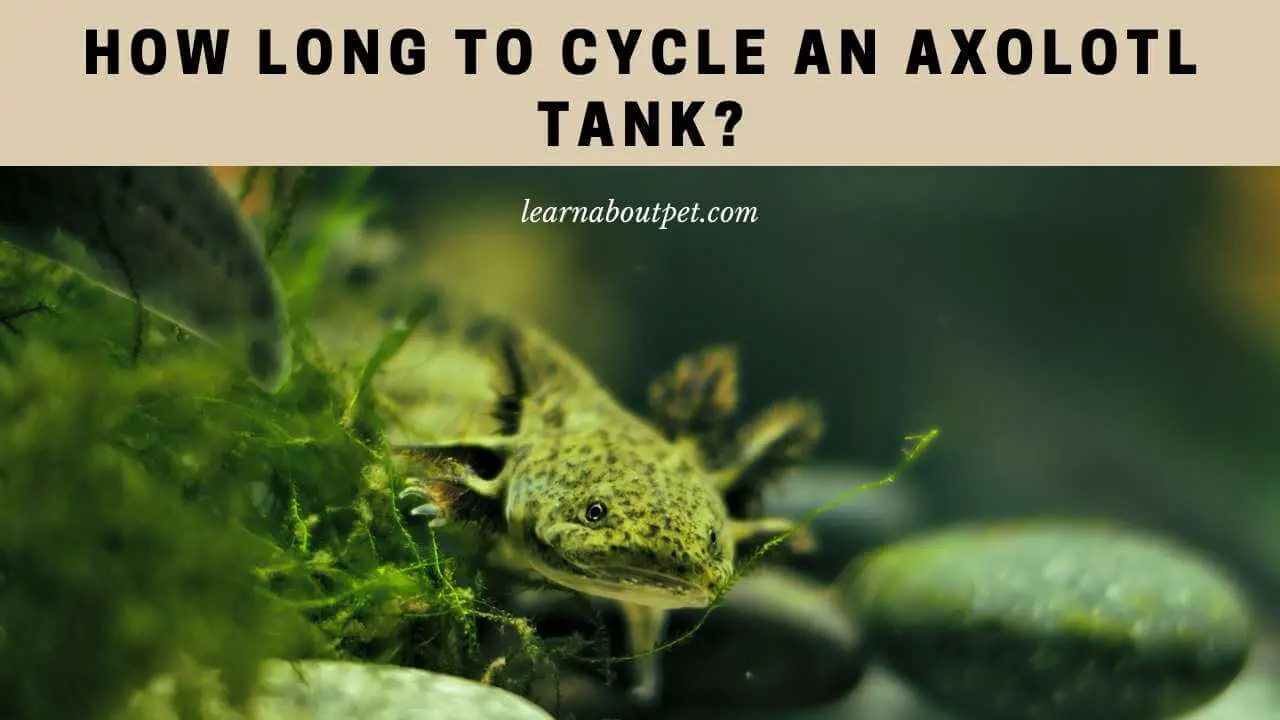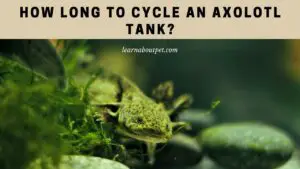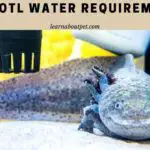Do you want to take care of an exotic pet like an axolotl? There are things you should do before placing an axolotl in your aquarium. Axolotls are very sensitive animals to water quality and temperature, so you must meet all the water parameters before being put into the aquarium. One way to meet the water parameters is by cycling the tank.
How long to cycle an axolotl tank? The cycling process is measured by ammonia and nitrite levels and typically takes 6-8 weeks. If you do a water test and the ammonia and nitrite levels don’t appear, you can add axolotl to the tank. If you want to add more than one axolotl, do it gradually.
For details on cycling and cleaning the tank and what if the axolotl is in an uncycled tank, let’s read this article to the end.

What Does Cycling An Axolotl Tank Mean?
Cycling an axolotl tank is a process to bring out beneficial bacteria in your filter. The beneficial bacteria will consume ammonia and convert it into nitrites. Another group of bacteria will consume nitrites and convert them to nitrates.
Cycling an axolotl tank has the same process as cycling any other fish. There are two ways to cycle the tank with the old method and the new method. You can learn both and use whichever you think is easier and less time-consuming.
Ammonia can arise from uneaten food, axolotl’s poop, and dead plants. Ammonia must be converted to NO2 (nitrite) and then to NO3 (nitrate) because ammonia alone can poison the axolotl. Then change the water once a week to ensure the nitrate level is always at a low level.
How long to cycle an axolotl tank? There is no strict timeline because you have to check the water regularly until the ammonia and nitrite levels are low. It can take 4-6 weeks if there are no fish in your tank at all, or 6-8 weeks in general.
Do You Have To Cycle An Axolotl Tank?
Because axolotls are pretty sensitive to ammonia or nitrite levels in the tank, it’s advisable to cycle your tank because if the axolotls are in an uncycled tank, they will eventually end up in their waste.
If you choose to do a water change only, the ammonia and nitrite levels will still rise. It’s the same as taking a risk by taking the axolotl and putting it in a tank that has many chances of not being healthy for the axolotl and can lead to death.
Axolotls are animals that produce a lot of waste. If they are in an uncycled tank, it is only a matter of time for ammonia levels to rise before the beneficial bacteria can convert to nitrites and nitrates.
How long to cycle an axolotl tank? If there are other fish in the tank, it takes 6-8 weeks to use fish waste as an ammonia source. If there is no fish at all, it will be faster, and the way to produce ammonia is to put fish food in a tank, leave it until the uneaten food releases ammonia.
How Do You Cycle An Aquarium For An Axolotl?
In addition to knowing how long to cycle an axolotl tank, we must know how to cycle a tank. First, fill the tank with dechlorinated water or tap water added with an aquarium water conditioner to remove chloramines and chlorine.
Set up the tank by decorating and installing filters. Add nitrifying bacteria to start the cycling process. Then introduce ammonia to feed the bacteria. After the process is running, use a water test kit to test the water parameters such as pH, KH, water hardness, nitrites, and nitrates.
Wait until the cycling is complete and takes more than 14 days. Still waiting until the nitrogen cycle is complete, then you can put the axolotl in the tank.
How Long To Cycle An Axolotl Tank?
Cycling an axolotl tank has a time difference if there is no fish in it or with fish in it. When you do cycling without using fish, it will take longer because someone has to produce ammonia. Meanwhile, ammonia can appear faster when fish are being fed, then produce waste.
How long to cycle an axolotl tank? The cycling process takes around 4-6 weeks with fish, while without fish, it takes 6-8 weeks. Don’t hurry to put the axolotl in the tank because the axolotl is very sensitive to water conditions in the tank.
If you are using an axolotl 20 gallon tank, add enough fish to speed up ammonia production from fish waste. Allow the cycling process to occur for up to 4 weeks before introducing the axolotl to the tank.
Axolotl Tank Not Cycling – What Should I Do?
If the axolotl tank is not cycling, three possibilities occur. Do a water test, then see the ammonia level. If ammonia is at 0, then that is a sign that you have not added enough ammonia.
Another problem is that ammonia is not converted to nitrites because there are not too many nitrifying bacteria in the tank. You can overcome this by adding more bottled bacteria and using filters that contain biological media.
The third problem is that ammonia has been converted to nitrites but cannot become nitrates. This is because the nitrites are too high. You need to change the water by about 20-30%.
If the axolotl tank is not cycling, do not put the axolotl because it is very risky. This is the concern of ‘how long to cycle an axolotl tank’ because cycling cannot be rushed until the nitrogen cycle is complete.
Axolotl In Uncycled Tank – Is It Unhealthy?
If you have axolotl in an uncycled tank, then they will stay on their waste for a long time because there are not enough bacteria to filter it. The ammonia and nitrite levels will continue to rise to dangerous levels and make the axolotl poisoned, leading to death.
If the axolotl continues to be in the tank, the axolotl can also experience digestive problems and continue to produce more waste and start floating. They look uncomfortable in tank conditions, and some axolotls will swim upside down or sideways.
How long to cycle an axolotl tank? Do a cycling tank 6-8 weeks before introducing axolotl to avoid many problems with water parameters.
Even though the axolotl is already in a cycled tank, you should always check the water parameters once a week and do water changes regularly to keep the water quality in the best condition.
Can You Cycle A Tank With An Axolotl In It?
If you want to cycle with the axolotl in it, many risks can occur even though you have to work extra to do water changes and constantly check the water parameters so that the ammonia, nitrites, and nitrates are at levels that do not harm the axolotl.

If you already have nitrifying bacteria and the axolotl has started producing waste, all you have to do is check whether the nitrites level is too high or normal. If it starts to get high, you need to change the water 20-30% every other day and check if the nitrites have started converting to nitrates.
You definitely can’t wait if you get an axolotl for sale and want to put it straight into the aquarium. To be more secure, you put the axolotl in an aquarium that has previously been filled with fish for a long time so that the cycling process is already running.
How long to cycle an axolotl tank? If you already have fish in it, you can expect a cycling process of between 4-6 weeks before you can introduce axolotls in the tank.
Axolotl In Tank Cycling
Axolotls cannot live in tanks with ammonia, nitrite, or nitrate levels that are too high because they can be toxic to their bodies. If the axolotl is in a cycling tank, you also still have to do water changes regularly because the axolotl produces a lot of waste.
If you see an axolotl poop in the tank, clean it immediately because it can break easily if left for more than a day. If the axolotl’s waste is not cleaned quickly, there is a possibility that the ammonia level will spike in a short time.
Axolotl in tank cycling can normally run if you can constantly check the water parameters according to the requirements.
How long to cycle an axolotl tank? To be safe, you need to cycle between 6-8 weeks before you introduce one or two axolotls at a time.
Which Is Better Cycle Tank With Axolotl In It Or Not?
There are some opinions of axolotl owners who cycle the tank with the axolotl inside without any problems, and there are also some who consider it risky. There are different ways of cycling tanks with or without axolotls. Below is the step difference if we are cycling the tank with or without axolotl.
| Step | With axolotl | Without axolotl |
| 1 | Set up aquarium and filtration system | Prepare and assemble your tank |
| 2 | Introduce hardy fish or axolotl to the tank | Add fish food or fish flakes and let it decay |
| 3 | Give food to the fish once every other day | Do ammonia test in a few days |
| 4 | Do 10-25% water change every few days | Keep the ammonia level at about 3 ppm |
| 5 | Use water test kits | Start testing nitrites after a week |
| 6 | Add another axolotl when toxin levels near zero | Wait until nitrites going low and rise in nitrates, and the cycling is almost complete |
Many axolotl owners prefer cycling a tank without axolotl in it because it has less risk. In addition, if you put the axolotl in it while cycling, you need a lot of fish other than the axolotl in the same tank so that the cycling process is faster.
While the axolotl will be more easily stressed if he feels overcrowded, axolotls are easily stressed, and with bad water, conditions will worsen their body condition.
How To Cycle A Tank In 24 Hours?
If you want to do a 24-hour cycle so you can put the axolotl in your tank faster, use an old filter from another tank that already has healthy bacteria to speed up the cycle process.
How long to cycle an axolotl tank? If you use an old filter and filter media from an old tank, you can add live bacteria and increase the oxygen level to do the cycling process in just one day.
How Long To Cycle A Tank With Old Filter?
If you use an old filter that already has beneficial bacteria and filter media such as rocks, gravel, plants, you can put it in a new tank and speed up the cycling process. You can speed up to half the time because the cycling process can be much faster.
Or, if you want an instant method, you can use live bacteria, increase the oxygen level, and increase the tank’s temperature. Do not do this when there are fish or axolotls in it because it will be very risky for them.
How long to cycle an axolotl tank with an old filter? You can estimate between two to three weeks, and it can be faster if you use live bacteria and some other additional requirements.
Final Verdict – How Long To Cycle An Axolotl Tank
Cycling an Axolotl tank water is required to keep the axolotl healthy like its natural habitat. The axolotl is an aquatic pet that is very sensitive to water conditions because it can affect their appetite, health, and behavior.

You can cycle by always checking ammonia, nitrites, and nitrates levels with a water test kit. If the nitrites or nitrates level is at a high number, you will need to do a water change of between 20-30% to return to normal levels.
Do not let your tank have high ammonia, nitrites, or nitrates so that the axolotls are not stressed and can lead to poisoning them.

Welcome to Learn About Pet. My name is Rajkumar Ravichandran and I love all pets, travel, and amazing food. I write about my passion and personal experience caring for multiple pets in this blog! ❤️
Post Disclaimer
DISCLAIMER: THIS BLOG OR WEBSITE, "Learn About Pet", DOES NOT PROVIDE YOU WITH MEDICAL ADVICE AND IS NOT A SUBSTITUTE FOR MEDICAL ADVICE. ALWAYS GET IN TOUCH WITH YOUR PERSONAL VETERINARIAN AND USE INFORMATION HERE AS GENERAL ADVICE.
The information, including but not limited to, text, graphics, images and other material contained on this website are for informational purposes only. No material on this site is intended to be a substitute for professional veterinary advice, food recommendation, diagnosis, or treatment. Always seek the advice of your veterinarian or other qualified health care provider with any questions you may have regarding a medical condition or for pet food related questions.







